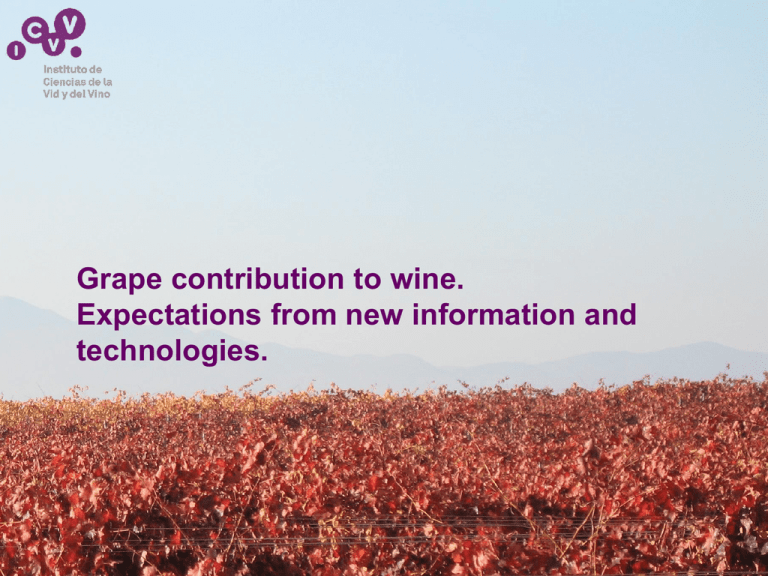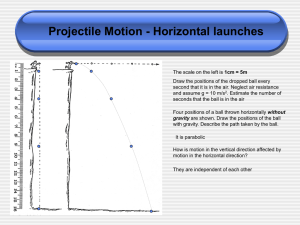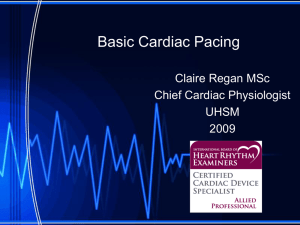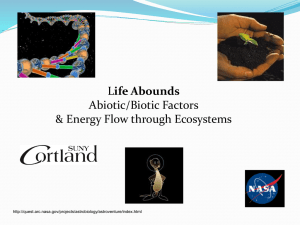
Grape contribution to wine.
Expectations from new information and
technologies.
Wine composition depends on must
composition and wine making
Wine is made up of more than
one thousand compounds
The majority of them come
from the grapes
Grapevine contribution
Exocarp
Mesocarp
Water
Organic acids
Malate
Tartrate
Sugars
Glucose
Fructose
Phenolic compounds
Tannins
Catechins
Anthocyanins
Other
Terpenes
Geraniol
Linalool
Terpineol
Nerolidol
Norisoprenoids
β-damascenone
β-ionone
Sulfur compounds
Factors determining the complexity
grapevine composition
Environment
Growth &
Development
Genotype
Genotype variation
• Rootstock genotype
• Cultivar genotype
• Somatic variation
• Cluster size and shape
• Berry size and shape
• Colour
• Taste
• Aroma
• Etc.
Environmental variation
Physical environment
Soil
Water
Light
Temperature
Cultural conditions
Trellis system
Prunning
Fertilization
Soil management
Irrigation
Developmental variation resulting from
genotype-environment interactions
Cluster number
Age of the plant
Flowering induction
Fertility
Cluster size/shape
Pollination
Fruit set
Berry size
Pollination
Irrigation
Berry development and ripening
Jordan Koutroumanidis, Winetitles
• Large amount of descriptive information on variation
between major cultivars as well as empirical information on
the effects of environmental factors and growing systems
• Reduced information on the molecular mechanisms
responsible for the processes of berry development and
ripening
• Almost no information on the genetic control of these
processes as well as on the molecular basis of natural
variation in composition and in environmental responses
Challenges for Viticulture in the XXI Century
• Quality production under sustainable systems
• Global climate change
Opportunities for Viticulture Research
• Grapevine genome sequence unraveled
• Functional genomics technologies
(transcriptomics, proteomics, metabolomics, etc.)
• Prospects to understand nucleotide diversity
related to phenotypic diversity
Grapevine genome sequence
• PN40024
• Reference gene set (30434)
• Reference genetic map (487 Mb)
• 41,4% Repetitive DNA
• Three ancestral genomes
• Large gene families for secondary
metabolites production (STS, TPS, etc.)
New tools to understand gene function
• Transcriptomics, Proteomics, Metabolomics
provide enhanced tools for phenotypic analyses
• Developmental processes
• Environmental responses
• Genetic differences among cultivars
• Rapid and improved generation of knowledge
on relevant processes
In a first step it should be possible to develop
models on how a cultivar system behaves
under different variables along its development
Second, we should be able to understand the
relationship between genotypic and phenotypic
diversity
New tools to understand gene function
• Custom made GrapeGen GeneChip
• 23096 probe sets
• About twice the information in commercial GeneChip
• Represent a consensus of vinifera sequences where
overlaps in EST data existed, or individual sequence data from
five cultivars: Cabernet Sauvignon, Muscat Hamburg, Pinot
Noir, Chardonnay, Shiraz
• Improved annotation and gene representation
BIN annotation facilitates the use of
functional analyses software applications
BINCODE NAME
4.4 Cellular reponse overview.Abiotic stress.Light
4.4 Cellular reponse overview.Abiotic stress.Light
4.4 Cellular reponse overview.Abiotic stress.Light
4.4 Cellular reponse overview.Abiotic stress.Light
4.4 Cellular reponse overview.Abiotic stress.Light
4.4 Cellular reponse overview.Abiotic stress.Light
4.5 Cellular reponse overview.Abiotic stress.Mineral
4.5 Cellular reponse overview.Abiotic stress.Mineral
4.5 Cellular reponse overview.Abiotic stress.Mineral
4.5 Cellular reponse overview.Abiotic stress.Mineral
4.5 Cellular reponse overview.Abiotic stress.Mineral
4.5 Cellular reponse overview.Abiotic stress.Mineral
4.5 Cellular reponse overview.Abiotic stress.Mineral
4.5 Cellular reponse overview.Abiotic stress.Mineral
4.5 Cellular reponse overview.Abiotic stress.Mineral
4.5 Cellular reponse overview.Abiotic stress.Mineral
4.5 Cellular reponse overview.Abiotic stress.Mineral
4.5 Cellular reponse overview.Abiotic stress.Mineral
4.5 Cellular reponse overview.Abiotic stress.Mineral
4.5 Cellular reponse overview.Abiotic stress.Mineral
4.5 Cellular reponse overview.Abiotic stress.Mineral
4.5 Cellular reponse overview.Abiotic stress.Mineral
4.5 Cellular reponse overview.Abiotic stress.Mineral
4.6 Cellular reponse overview.Abiotic stress.Osmotic
4.6 Cellular reponse overview.Abiotic stress.Osmotic
4.6 Cellular reponse overview.Abiotic stress.Osmotic
4.6 Cellular reponse overview.Abiotic stress.Osmotic
IDENTIFIER
VVTU33616_x_at
VVTU40431_at
VVTU40867_x_at
VVTU7881_at
VVTU18150_at
VVTU33020_x_at
VVTU16733_s_at
VVTU35241_at
VVTU1390_s_at
VVTU1295_at
VVTU24339_at
VVTU13091_at
VVTU16936_at
VVTU19149_at
VVTU22224_s_at
VVTU37244_at
VVTU3222_at
VVTU3659_at
VVTU26592_at
VVTU14798_at
VVTU25240_at
VVTU33825_at
VVTU32192_at
VVTU18099_at
VVTU12252_s_at
VVTU16349_at
VVTU1165_at
DESCRIPTION
Q8W540 Early light-induced protein-like protein related cluster
Q8W540 Early light-induced protein-like protein related cluster
Q8W540 Early light-induced protein-like protein related cluster
Q8W540 Early light-induced protein-like protein related cluster
Q94F86 Early light inducible protein related cluster
Q94F86 Early light inducible protein related cluster
O82730 Monogalactosyldiacylglycerol synthase related cluster
O82730 Monogalactosyldiacylglycerol synthase related cluster
Q3HVL7 TSJT1-like protein related cluster
Q69F98 Phytochelatin synthetase-like protein related cluster
Q6K1X0 Putative iron-stress related protein related cluster
Q6UK15 Al-induced protein related cluster
Q6UK15 Al-induced protein related cluster
Q6UK15 Al-induced protein related cluster
Q6UK15 Al-induced protein related cluster
Q6UK15 Al-induced protein related cluster
Q7Y0S8 Erg-1 related cluster
Q7Y0S8 Erg-1 related cluster
Q84JR4 Phytochelatin synthase related cluster
Q8LGF0 NOI protein related cluster
Q8LGF0 NOI protein related cluster
Q94KH9 Aluminium induced protein related cluster
Q9S807 Phosphate starvation regulator protein related cluster
O04895 Betaine-aldehyde dehydrogenase, chloroplast precursor related cluster
Q6JSK3 Betaine aldehyde dehydrogenase related cluster
Q6S9W9 Betaine-aldehyde dehydrogenase related cluster
Q8H5F0 Betaine aldehyde dehydrogenase-like related cluster
TYPE
T
T
T
T
T
T
T
T
T
T
T
T
T
T
T
T
T
T
T
T
T
T
T
T
T
T
T
Transcriptional analyses of berry
development and ripening
Greeen stages
2 mm
7 mm
Veraison
15 mm
v 50
Berries
Exocarp
Mesocarp
Seeds
Total RNA extraction
RNA labeling and GeneChip Hybridization
Cluster analyses (K-means)
Functional analyses (Babelomics)
Functional analyses (Mapman)
Ripening
v100
120
130-150
Muscat Hamburg
3 independent biological replicas
2 different years (2005-2006)
Cell wall metabolism along berry development
in Muscat Hamburg
Veraison
Ripening
Green
Skin
Flesh
BIN Name
3
3.1
3.2
3.4
3.3
Cell wall metabolism
Cell wall metabolism.Cell wall biosynthesis
Cell wall metabolism.Cell wall modification
Cell wall metabolism.Related protein
Cell wall metabolism.Structural protein
Elements
639
193
296
68
82
Corrected P values
Green Veraison Skin Veraison Flesh Ripening Skin
0.284
0.996
0.150
5.409 E-4
3.680 E-4
0.257
0.001
0.595
0.112
0.996
0.818
1.173 E-4
0.301
0.550
0.533
0.123
0.614
0.001
0.050
0.109
Ripening Flesh
9.131 E-8
0.031
6.438 E-6
0.004
0.799
Secondary metabolism differences
between CR and RG
Flesh
RG
Skin
BIN
19
19.1
19.4
19.4.1
19.4.1.1
19.4.1.3
19.4.2
19.4.4
Name
Secondary metabolism
Secondary metabolism.Alkaloids
Secondary metabolism.Phenylpropanoids
Secondary metabolism.Phenylpropanoids.Flavonoids
Secondary metabolism.Phenylpropanoids.Flavonoids.Anthocyanin biosyhthesis
Secondary metabolism.Phenylpropanoids.Flavonoids.Flavonoids
Secondary metabolism.Phenylpropanoids.Phytoalexins
Secondary metabolism.Phenylpropanoids.General pathway
Elements
531
50
271
193
51
128
50
28
Corrected p-value
Flesh
Skin
0.003 1.56933E-05
0.039
0.932
0.059 3.47419E-06
0.332
0.070
0.258
0.480
0.057
0.071
0.329 4.43752E-05
0.158
0.008
CR
New tools to understand gene function
Genetic control of relevant traits
• Genetic and molecular identification of genes
responsible for relevant traits
• Understanding the relationship among
nucleotidic and phenotypic diversity
• Genetic variation
• Natural genetic variation (cultivars and
clones)
• Artificial variants (mutant collections)
• Genetic transformation
• Molecular tools
• Molecular markers (SSRs and SNPs)
New tools to understand gene function
Molecular markers: SNPs
1
2
3
4
0
SNP829_281
0
SNP613_315
11
17
24
25
27
29
31
32
39
SNP1439_90
SNP1453_40
SNP229_112
Vvi_1196
SNP683_120
SNP129_237
SNP1427_120
SNP1517_271
SNP1527_144
SNP269_308
SNP851_110
SNP357_371
SNP517_224
SNP1241_207
11
16
19
22
SNP1293_294
SNP437_129
SNP1487_41
SNP581_114
13
16
33
Vvi_9227
SNP553_98
SNP497_281
SNP867_170
SNP425_205
SNP1493_58
SNP1563_280
53
56
61
63
SNP477_239
Vvi_6934
SNP1025_100
SNP1021_163
SNP1157_64
54
3
25
26
SNP1219_191
48
SNP1229_219
Vvi_805
9
8
0
6
7
8
SNP289_84
Vvi_6936
SNP593_149
Vvi_1810
20
25
SNP699_311
SNP929_81i
13
SNP1057_505
SNP663_578
SNP311_198
SNP1211_166
Vvi_10992
23
Vvi_7871
0
3
5
42
40
42
45
53
54
55
63
65
SNP853_312
SNP1203_88
SNP1323_155
SNP1553_395
SNP865_80
SNP377_251
SNP1481_156
SNP1499_126
Vvi_2283
75
78
82
SNP1385_86
SNP1055_141
SNP1295_225 10
SNP881_202
56
SNP571_227
8
9
18
35
37
SNP447_244
SNP1437_100
46
SNP397_331
0
Vvi_2319
SNP325_65
Vvi_2292
Vvi_1222
33
37
40
SNP1411_565
SNP421_234
Vvi_3163
SNP897_57
SNP1035_226
7
10
24
26
SNP1513_153
SNP255_265
SNP1409_48
SNP655_93
32
35
37
SNP191_100
SNP715_260
Vvi_6668
51
54
57
59
64
67
69
70
SNP281_64
SNP891_109
SNP135_316
SNP811_42
SNP1559_291
Vvi_10516
SNP1399_81
Vvi_2543
0
5
SNP197_82
SNP635_21
24
SNP987_26
SNP341_196
SNP451_287
SNP1507_64
SNP1371_290
SNP227_191
Vvi_3212
36
42
43
Vvi_1280
Vvi_11273
SNP555_132
54
SNP1311_48
SNP317_155
SNP1423_265
Vvi_10353
16
7
14
27
48
7
6
0
1
SNP1071_151 11
SNP1431_584 13
SNP1053_81 14
SNP625_278 17
SNP1471_179 19
SNP855_103
Vvi_5316
SNP1235_35 32
Vvi_10113
SNP567_341 40
41
Vvi_11572
SNP1027_69
0
12
13
14
19
24
25
28
30
41
44
55
SNP945_88
SNP1109_253
SNP1345_60
Vvi_2021
SNP873_244
SNP709_258
SNP1213_99
SNP915_88
SNP1393_62
2
3
10
11
SNP1347_100
SNP691_139
Vvi_2623
Vvi_3400
20
24
30
Vvi_13076
SNP1397_215
SNP1583_159
45
46
48
SNP1015_67
Vvi_1731
SNP241_201
58
SNP961_139
Vvi_5629
71
74
77
79
SNP1495_148
SNP1419_186
SNP1151_397
SNP429_101
88
91
94
SNP1445_218
Vvi_377
Vvi_12805
SNP559_110
SNP895_382
SNP1043_378
SNP1033_76
Vvi_10383
60
12
SNP1201_99
SNP189_131
SNP1215_138
SNP557_104
3
4
5
7
22
Vvi_12882
Vvi_589
13
Vvi_4146
0
44
50
54
15
14
0
3
9
15
11
SNP649_567
SNP947_288
SNP1029_57
SNP283_32
Vvi_10329
23
24
54
57
10
5
0
6
9
SNP1119_176
17
5
11
15
17
26
27
28
29
SNP1023_227
SNP1045_291
SNP1003_336
Vvi_221
SNP1001_250
SNP355_154
SNP453_375
Vvi_1617
SNP1519_47
Vvi_196
44
Vvi_9920
57
58
SNP883_160
SNP415_209
24
31
33
66
SNP1391_48
42
78
Vvi_10777
SNP677_509
LFY-ET2_351
Vvi_6987
SNP1335_204
SNP1231_54
SNP1079_58
VBFT_361
SNP1349_174
33
SNP579_187
40
SNP877_268
62
18
50
SNP879_308
SNP1187_35
SNP653_90
SNP351_85
Vvi_7387
SNP259_199
SNP1363_171
30
32
37
43
19
49
SNP817_209
SNP459_140
SNP253_145
SNP819_210
Vvi_7824
Vvi_1187
SNP1127_70
Identification of QTLs and genes
QTL analyses
• Flower sex
• Berry color
• Berry size
• Muscat flavor
• Seedlessness
• Seed number
• Leaf shape
• Powdery mildeu resistance
• Downy mildeu resistance
• Pierce’s disease resistance
• Nematode resistance (Xiphinema index)
• Low magnesium uptake
• Flowering time
• Veraison time
• Veraison period
Spontaneous mutations
• Flower sex
• Berry color (multiple cultivars)
• Berry size (Grenache)
• Berry flesh (Ugni blanc)
• Muscat flavor (Chaselass)
• Acid content
• Seedlessness (Sultanina)
• Internode length (Pinot Menieur)
• Leaf shape (Chaselass)
• Cluster size (Carignan RRM)
GeneChips can also help identify genes
altered in somatic variants
IS1
• Carignan somatic variant RRM
• Reiterated Production of reproductive meristems
• Delayed flower anthesis
• Larger cluster size and complexity
Caused by natural trans-activation from a
transposable element insertion in VvTFL1A
promoter
IS2
IS3
Applications in viticulture
• Diagnostic tools
•Evaluation of plant physiopathological conditions
• Evaluation of the effect of cultural practices
• Breeding tools
• Clonal selection, identification and protection
• Marker assisted breeding of new cultivars
Tempranillo tinto
Tempranillo blanco
Acknowledgements
Diego Lijavetzky
José Díaz-Riquelme
Lucie Fernández
Rita Francisco
José Antonio Cabezas
CNB-CSIC, Madrid, Spain
CNB-CSIC, ETSIA-UPM, Madrid, Spain
CNB-CSIC
ITQB, Lisboa, Portugal
IMIDRA, Madrid, Spain
Collaborators:
Maria José Carmona ETSIA-UPM
Juan Carreño
IMIDA, Murcia, Spain
Laurent Torregrosa INRA/SupAgro-UMR, Montpellier, FR








